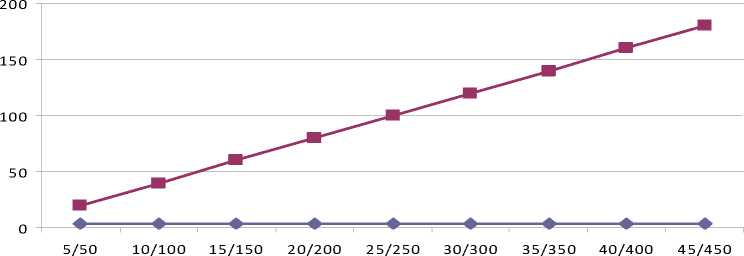Packet header size
This performance metric is to evaluate the scalability feature in the proposed protocol in
comparison to Xcast+ protocol. In this evaluation, both the packet header size in the source
node and for each data packet received is calculated. In the first part of evaluation, the
calculations were done to find the size of the header that initially encoded in the data packet
in the source node in order to send this data packet. Moreover, at the second part the
calculations were done to find the average header size encoded for each data packet from the
source to reach the destinations.
Figure 4.25 shows the results obtained for the first part of packet header size evaluation. It
can be noticed that SReM has got static header size even when the group size is increasing.
This result comes because whatever the group size SReM will only include the next
Branching Node Router (BNR) addresses in the header of each data packet. In Xcast+ the
results show that an exponential increase of header size when the group size increases. The
increase of header size will cause energy consumption in the intermediate node and a delay
of delivery packets, because the intermediate nodes will take long time and energy for
processing the header. In conclusion, SReM improve the scalability feature because the
header size is constant even when the group size increases.
Header size for data packets initialized in the source
node

♦ SREM
H Xcast+
Group Size (LMRsZReceivers)
Figure 4.25 Extra packet header size as a function of group size
93
More intriguing information
1. What should educational research do, and how should it do it? A response to “Will a clinical approach make educational research more relevant to practice” by Jacquelien Bulterman-Bos2. The name is absent
3. Literary criticism as such can perhaps be called the art of rereading.
4. SLA RESEARCH ON SELF-DIRECTION: THEORETICAL AND PRACTICAL ISSUES
5. Outline of a new approach to the nature of mind
6. Wirkung einer Feiertagsbereinigung des Länderfinanzausgleichs: eine empirische Analyse des deutschen Finanzausgleichs
7. New Evidence on the Puzzles. Results from Agnostic Identification on Monetary Policy and Exchange Rates.
8. INTERPERSONAL RELATIONS AND GROUP PROCESSES
9. Opciones de política económica en el Perú 2011-2015
10. The name is absent